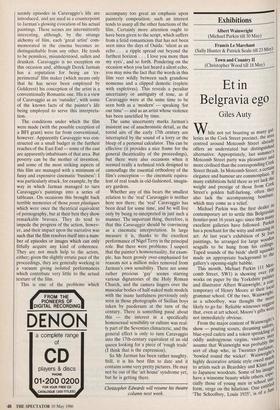Exhibitions
Albert Wainwright (Michael Parkin till 30 May) Francis Le Marchant (Sally Hunter & Patrick Seale till 23 May)._ Town and Country II (Christopher Wood till 18 May)
Et in
Belgravia ego
Giles Auty
While not yet boasting as many gal- leries as the Cork Street precinct, the area centred around Motcomb Street alreadY, offers an understated but distinguishen alternative. Appropriately, last sumaler',s Motcomb Street party was pleasanter and more civilised than the corresponding Cork Street thrash. In Motcomb Street, a certain, elegance and humour are commonplace. h many exhibitions held there as yet lack the weight and prestige of those from Cork Street's golden half-furlong, often they also lack the accompanying bombast' which may come as a relief. Michael Parkin was the first dealer in contemporary art to settle this Belgravia° frontier-post 16 years ago; since then Man! excellent galleries have followed. Parn has a penchant for the witty and amusing° art. At last year's exhibition of St Ives paintings, he arranged for large wooden seagulls to be hung from his ceiling. Taped sounds of the birds' shrill squaWks made an appropriate background to the gallery's opening-night babble. This month, Michael Parkin (11 1\41; comb Street, SW1) is showing over '. r works on paper by the Yorkshire painter and illustrator Albert Wainwright, a °jai temporary of Henry Moore at their Inct grammar school. Of the two, Wainwrigh; as a schoolboy, was thought the Ina t likely to go far. Reliable witnesses sugges,, that, even at art school, Moore's gifts wet' not immediately obvious. From the major content of Wainwrights show — pouting scouts, dreaming sailnrsoi blue-eyed cadets and a token sprinkling „ oddly androgynous virgins, visitors In!'e assume that Wainwright was probablY the sort of chap who, in Twenties parlanctG,s 'bowled round the wicket'. Wainwrigh„b highly decorative artistic style owed Inn'd to artists such as Beardsley and Klirnt an s to Japanese woodcuts. Some of his iMa8ye.. have a winsome beauty while others, esP ,.. cially those of young men in school nn'A form, verge on the hilarious. One entitleut 'The Schoolboy, Louis 1935', is of a ins William who has just discovered mummy's mascara. Wainwright was a talented and, given the times, isolated artist who died in 1943. The climate in which he lived his life was very different from — but not neces- sarily worse than — our own.
At Sally Hunter & Patrick Seale (2 Motcomb Street, SW1), Francis Le Mar- chant is showing over 60 small oils and watercolours, mostly from Mediterranean sojourns. This is a pleasant and profes- sionally put-together exhibition from Which some necessary spark nevertheless seems missing. The artist can and often does paint well; 'The Dordogne Valley near Loubersac' and 'Riverside Garden, Chiswick Mall' are small compositions with genuine charm and sparkle. Equally, `Tra- Pani from Erice, Sicily' shows the artist has the ability to seek out a composition unusual enough to seize the viewer's atten- tion. Even for the most committed land- scape painter the beauties of an area require personal re-interpretation if they are to become anything more than agree- able topography. Some of Le Marchant's Oil paintings remain trapped in the no- man's land between the freshness of a sketch and the intensity of a highly consi- dered painting. In going too far, they sometimes fail to go far enough. The nature of watercolour, a largely neglected medium these days, can aid an artist to overcome this problem. In Pythagonon' 1-e Marchant makes good, clean use of its potential. This is an attractive exhibition by an artist with capacity to go further. The art of architectural painting, like the Skilled use of watercolour, has steadily declined. On the other hand, how an early49th-century watercolourist might have coped with the lumpish proportions and stained concrete exteriors of many modern buildings defies imagination. W. hile the appearance of traditional build- ing materials — stone, brick, cob and wood generally improves and mellows with age, concrete grows to look increasingly worse. Modern architectural paintings and drawings often need to disguise, through s. tylisation, how a building will look. That In earlier times such a degree of licence was unnecessary is made clear in a fascinating exhibition of London and country house views and designs at Christopher Wood (15 lgotcomb Street, SW1). The quality of Many of the early paintings and drawings is excellent. A small ink and watercolour drawing of Castle Howard by Francis Nicholson combines accuracy with poetry and there are similarly exquisite works by such as Thomas Allom (1804-1872) and Frederick Hulme (1816-1884). The latter even manages to work a superbly flam- noYa. nt sky — which owes much to Turner into a watercolour of the Carnivora large at Regent's Park Zoo. Oddly, a k ,arge oil painting c.1880 of Lynford Hall, ;,9Lundford, Norfolk, remains unattributed. know some alert Spectator reader will know the answer?



























































 Previous page
Previous page